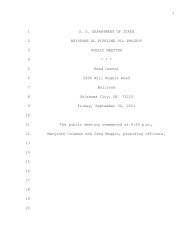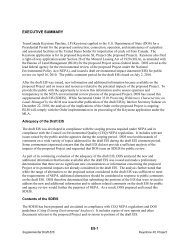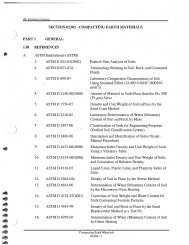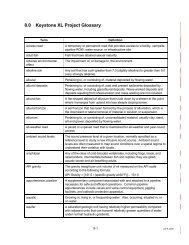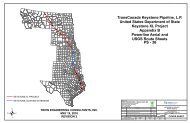2.1 Overview of the Proposed Project - Keystone XL pipeline - US ...
2.1 Overview of the Proposed Project - Keystone XL pipeline - US ...
2.1 Overview of the Proposed Project - Keystone XL pipeline - US ...
You also want an ePaper? Increase the reach of your titles
YUMPU automatically turns print PDFs into web optimized ePapers that Google loves.
Draft Supplemental Environmental Impact Statement<strong>Keystone</strong> <strong>XL</strong> <strong>Project</strong>StateCountyStructures Within 25 Feet <strong>of</strong>Construction ROW (Number)Structures Within 500 Feet <strong>of</strong>Construction ROW (Number)Boone 0 33Nance 0 15Merrick 0 8Polk 0 19York 0 20Fillmore 0 7Saline 0 14Jefferson 0 11<strong>2.1</strong>.8.7 Fences and GrazingFences would be crossed or paralleled by <strong>the</strong> construction ROW. Before cutting any fence for<strong>pipeline</strong> construction, each fence would be braced and secured to prevent <strong>the</strong> slacking <strong>of</strong> <strong>the</strong>fence. To prevent <strong>the</strong> passage <strong>of</strong> livestock <strong>the</strong> opening in <strong>the</strong> fence would be closed temporarilywhen construction crews leave <strong>the</strong> area. All existing fencing and grazing structures, such asfences, gates, irrigation ditches, cattle guards, and reservoirs would be repaired topreconstruction conditions or better upon completion <strong>of</strong> construction activities. If gaps in naturalbarriers used for livestock control are created by <strong>pipeline</strong> construction, <strong>the</strong> gaps would be fencedaccording to <strong>the</strong> landowner’s requirements. All existing improvements, such as fences, gates,irrigation ditches, cattle guards, and reservoirs would be maintained during construction andrepaired to preconstruction conditions or better upon completion <strong>of</strong> construction activities.<strong>2.1</strong>.9 Waterbody CrossingsIn <strong>the</strong> final design phase <strong>of</strong> <strong>the</strong> proposed <strong>Project</strong>, perennial waterbody crossings would beassessed by qualified personnel with respect to <strong>the</strong> potential for channel aggradation ordegradation and lateral channel migration. The level <strong>of</strong> assessment for each crossing would varybased on <strong>the</strong> pr<strong>of</strong>essional judgment <strong>of</strong> <strong>the</strong> qualified design personnel. The <strong>pipeline</strong> would beinstalled as necessary to address any hazards identified by <strong>the</strong> assessment. The <strong>pipeline</strong> would beinstalled at <strong>the</strong> design crossing depth for at least 15 feet beyond <strong>the</strong> design lateral migrationzone, as determined by qualified personnel. The design <strong>of</strong> <strong>the</strong> crossings also would include <strong>the</strong>specification <strong>of</strong> appropriate stabilization and restoration measures.The actual crossing method employed at a perennial stream would depend on permit conditionsfrom U.S. Army Corps <strong>of</strong> Engineers (<strong>US</strong>ACE) and o<strong>the</strong>r relevant regulatory agencies, as well asadditional conditions that may be imposed by landowners or land managers at <strong>the</strong> crossinglocation. Where <strong>the</strong> HDD method is not used for major waterbody crossings or for waterbodycrossings where important fisheries resources could be impacted, a site-specific plan addressingproposed additional construction and impact reduction procedures would be developed (seeCMRP, Appendix G). Prior to commencing any stream-crossing construction activities, at aminimum, permits would be required under Section 404 <strong>of</strong> <strong>the</strong> Clean Water Act through<strong>US</strong>ACE, and Section 401 Water Quality Certification, per state regulations. These agenciescould require measures to limit unnecessary impacts such as requiring all <strong>the</strong> non-HDD crossingsto be constructed during dry conditions. Additional information on <strong>the</strong> types <strong>of</strong> crossing methodsproposed for use on <strong>the</strong> proposed <strong>Project</strong> is presented in <strong>the</strong> subsections below.<strong>Project</strong> Description <strong>2.1</strong>-55 March 2013



